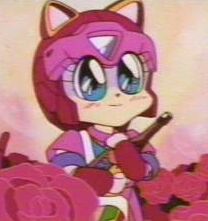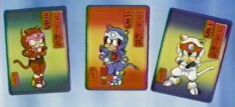Nan-hon des' ka? *Ippon* |
Nan-nin des' ka? (OK, they are animals, but for the test we are counting them as people.)  *Roku-nin* |
Nan-mai des' ka? *San-mai* |
Ikutsu no hato-gata (hearts) des' ka? *Nanatsu* |
 Last time I mentioned that the Japanese have different ways to count different things. In the last lesson, we learned the basic Japanese numbers. Like the Kanji writing system, this was brought to Japan from China. Before the Chinese numbers were brought over, the Japanese had their own. These older numbers are sometimes used for counting, so, you need to learn them. The good news is, you only need to learn 1-10, because after number 10, you use the basic numbers we learned last time.
Last time I mentioned that the Japanese have different ways to count different things. In the last lesson, we learned the basic Japanese numbers. Like the Kanji writing system, this was brought to Japan from China. Before the Chinese numbers were brought over, the Japanese had their own. These older numbers are sometimes used for counting, so, you need to learn them. The good news is, you only need to learn 1-10, because after number 10, you use the basic numbers we learned last time.
1= Hitotsu (hee-toh-su)
2= futatsu (f'ta-su)
3= mittsu (meet-su)
4= yottsu (yoht-su)
5= itsutsu (eet-su-su)
6= muttsu (moot-su)
7= nanatsu (nah-naht-su)
8= yattsu (yat-su)
9= kokonotsu (ko-ko-no-su)
10= to (toh)
These numbers by themselves are used to count things that don't have their own special way of being counted, like "Piza wa yottsu arimas'" = "Pizza, four I have." = "I have 4 pizzas." You can ask how many with "Ikutsu" (ee-ku-su)="How many". Like "Ikutsu arimas' ka?" = "How many do you have?". "Ikutsu" can also be used to ask "how old" someone is.
OK, so now you know one general way of counting. But a lot of Japanese number words are combined with a suffix (word ending) which varies according to what it is that is being counted. Does that sound complex to you? Well, it is, but it's not as different as you might think. You see, English does the same things sometimes, like; "12 sheets of paper", "300 head of cattle", and "7 pairs of pants". These words are called "Quantitative Expressions" (because they express quantity). You can make yourself understood to Japanese if you just know the numbers, but then you'd say something like "12 papers" instead of "12 sheets of paper". I'm not going to try and teach you all of these in this one lesson, but we'll go over a few common ones.
Counting people is done with the quantitative expression "-nin" (neen) like in "ninja", if that helps you to remember. Three people would be "san-nin". BUT, one person is "Hitori"(hee-toh-ree), which comes from the old style Japanese number "hitotsu" we just learned. It's sort of like saying "a single person" instead of saying "1 person". Two people is a couple in English, and in Japanese, it's "futari" (f'ta-ree), once again based on the old style Japanese number. After that, you can use the regular Japanese number with "-nin" added to count however many people there are. "san-nin", "yon-nin" "go-nin", etc.
I mentioned sheets of paper as an example earlier. In Japanese, flat, thin objects, like paper, sheet metal, glass window panes, and so on, are counted in "-mai". It's easy, because all you have to do is add "-mai" to the basic Japanese numbers we learned in the last lesson: "Ichi-mai", "Ni-mai", "San-mai".
Calendrical objects, like bottles, cans, and even pens and pencils, are counted with "-hon". But it's not so simple as "-mai", because "-hon" will change to "-pon" or "-bon" depending on the number! 1 to 10 goes like this:
ippon, ni-hon, sam-bon, yon-hon, go-hon, ro-pon, nana-hon, ha-pon, kyu-hon, ju-pon
Don't think you can remember all that? Don't worry. If you hear someone saying a number ending with "-hon", "-pon", or "-bon", you'll know what they are talking about. And if you want 4 sodas, just ask for "yottsu soda kudasai". You won't impress anyone with you mastery of the Japanese language, but you'll get your 4 sodas. And if you can remember "ippon", you can at least get one for yourself.
Small things, like bottle caps, pebbles, and erasers are counted with "-ko". One small thing is "ikko" (for a lot of the Japanese quantitative expressions, "Ichi" is shortened to just "i" (ee) plus whatever the ending is, that's why we have "ikko" and "ippon" instead of "ichi-ko" and "ichi-pon"), 2 is "ni-ko", 3 "san-ko", and so on. No tricky changes like with "-hon".
Now, let's quickly go over some of the other quantitative expressions. I'm not going to go into detail on them in this lesson, but maybe you can start listening for them when you're watching some anime.
"-dai" is used for machines, including cars, computers, telephones, etc.
"-ken" is used for buildings.
"-hiki" is used for smaller animals, like cats, fish, dogs, etc.
"-tou" is used like "head" is used in English for counting bigger animals, like cows and horses.
"-hai" is like "cup of" or "glass full" in English, used to count liquids.
"-wa" is used to count birds, and I've heard it can be used to count rabbits too!
"-kai" is used to count floors of buildings, innings in sports, and times/frequency.
If you don't think you can learn all those quantitative expressions right now, don't panic. If you keep listening to Japanese and studying, you'll eventually start to pick them up. One more thing, you can ask the amount of anything by adding "nan" to the quantitative expression endings for the objects. Like "Nan-nin" is "how many people", "Nan-mai"="how many sheets", etc. What ever doesn't have a special way to be counted (or if you just can't remember), just use "Ikutsu".
But wait! You can't go yet! There's a test today. Daijobu, it's not hard, and you won't be graded. It's just for practice.
Nan-hon des' ka? *Ippon* |
Nan-nin des' ka? (OK, they are animals, but for the test we are counting them as people.)  *Roku-nin* |
Nan-mai des' ka? *San-mai* |
Ikutsu no hato-gata (hearts) des' ka? *Nanatsu* |